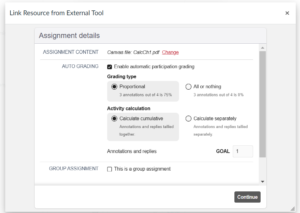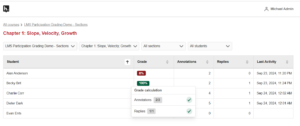Instructors using the Hypothesis LMS app may find themselves grading based on student participation, typically calculating a grade based on the number of annotations and/or replies students make over a text in order to acknowledge their effort, without necessarily basing the grade off of annotation content. In order to simplify this process and save instructors time, we’ve created an Auto Grading feature that will automatically calculate a grade based on counts of notes and, if the instructor wants, send those grades to the LMS gradebook.
Auto Grading can be added to new assignments, or it can be applied retroactively to existing assignments, even if those assignments already contain student annotations. Any document type that allows students to annotate (videos, PDFs, websites, etc.) can be used with Auto Grading.
Here’s a video to see how Auto Grading works in Hypothesis assignments.
Setting up Auto Grading in Hypothesis

Create a new assignment or edit an existing one
In a new or existing assignment, get to the Hypothesis assignment creation module. As usual, select the document you wish to use in your assignment.
Enable the feature
After the document is selected, check the box next to “Enable automatic participation grading”.
Select a Grading type
“All or Nothing” grades will give 100% or 0% of the points available in your assignment. You will specify Minimums numbers your students must reach to get full credit. If you ask for four annotations, students with three annotations will get 0%.
“Scaled” grades will give a grade that’s proportionate to the Goal you specify. If you ask for four annotations, students with three annotations will get 75%.
For both grading types, the max grade is 100%. If you ask for four annotations, students with five annotations would only get the 100% credit as if they had made four.
Select the Activity calculation
“Calculate cumulative” will use a combined count of annotations and replies and work towards a single number. If you ask for four total notes, students with two annotations and one reply will receive a 3/4 = 75%.
“Calculate separately” will ask you to specify both a count of annotations and a count of replies.
- For “All or Nothing” grades, failing to get to the minimum in either or both categories results in a failure. If you ask for two annotations and two replies, students with two annotations and only one reply get a 0%.
- For “Scaled” grades, extra annotations do not make up for a shortfall of replies, and vice versa. If you ask for two annotations and two replies, students with three annotations and one reply get a 75% (3/2 annotations counting as 2/2 annotations, and 1/2 replies, meaning 3/4 possible notes).
Choose the number of notes required
Set your Goal or Minimum number of notes that students need to reach. Afterwards you can finish creating your assignment as you normally would.
Viewing and Syncing grades

The automatically calculated grades provided by this feature will appear on the LMS Reporting Dashboards. Grades will appear in their own column which, like other columns in the Reporting Dashboards, is sortable.
If you hover your cursor over an individual grade you’ll get a Popover which will give you additional information showing how the grade was calculated.
You’ll also see a Grade Sync button in the top right of the screen. Pressing this button will take any grades you haven’t synced already and send them to your LMS Gradebook. Doing this will overwrite any grades that may already be in the Gradebook. If the grades in Hypothesis change (e.g., a student creates more annotations, or the instructor changes the grading settings) then any new grades will get marked with the word NEW. For subsequent grade syncs only the NEW grades will get sent to the LMS Gradebook.
Grade Sync works for students that are included in your LMS course, assignment, and other rosters. Read more about the different types of rosters the Hypothesis LMS app may use here.
Auto Grading and other features
Auto Grading and Sections / Groups assignment
In some assignments the instructor may wish to use our Canvas Sections, or LMS Groups, integrations. These integrations will continue to work normally when Auto Grading is turned on; students will only see annotations made by other students in their same Group/Section.
The automatic grades are still calculated on an individual basis. There are no group grades in Hypothesis.
Auto Grading and manually grading in the same assignment
There may be times where you still wish to use Hypothesis’ integration with SpeedGrader (in Canvas) or use the Hypothesis grading bar (in other LMSs); for example, you may wish to leave grading comments for certain students.
After syncing your participation grades to the LMS Gradebook you can use SpeedGrader or our grading bar to view the grades that are currently in the LMS Gradebook, change them, leave grading comments, etc. Please note that changing a grade in the LMS Gradebook (either by using our grading bar, directly editing the LMS Gradebook, etc) will not change the calculations shown in the Reporting Dashboards.
If you plan on syncing the automatically calculated grades from Hypothesis to the LMS Gradebook, we recommend doing that first and then further editing them elsewhere if you wish.
How can I use this feature?
Sort your assignments by grade to focus your instructional interventions
Even if you don’t ultimately sync participation grades back to the LMS Gradebook, you can use this feature to quickly see who is struggling with a given assignment to make it easy to reach out to them. Since grades will keep recalculating as students add annotations you can monitor who may not be hitting the targets before the actual assignment due date if needed.
Quickly compare the effort of different Groups or Sections
By using the Groups/Sections filter on the Reporting Dashboard (available when you are using our LMS Groups or Canvas Sections integrations as part of your assignment) you can quickly cycle through individual student grades while viewing them in the context of the overall Group. This lets you easily find instances where a group, as opposed to individuals, needs collective help.
Focus your targets on the behaviors you want to promote
Whether you make students aware of the targets and plan to sync the results to the LMS Gradebook, or if you don’t alert students to your grading scheme and keep the results to yourself, you can use the results to test if students are meeting your instructional goals. If you’re looking for a lot of social interaction, try setting up a Scaled assignment with separate calculations and making the Minimum for Replies fairly high. You can then quickly determine if your instructions and examples concerning social annotation are sufficient to drive that student behavior, or if other class-wide interventions are needed.